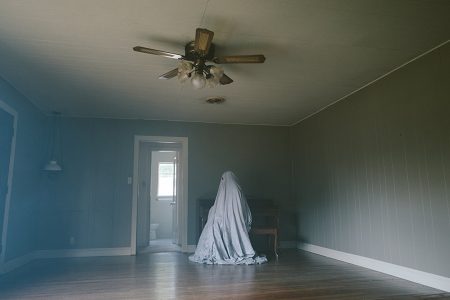![]() Who invented the bedsheet ghost? The image of a ghost marked by donning a white sheet with holes for eyes is a classic and familiar concept. It’s so familiar, it hardly seems scary–it is more bizarre than terrifying. Enter David Lowery’s “A Ghost Story.”
Who invented the bedsheet ghost? The image of a ghost marked by donning a white sheet with holes for eyes is a classic and familiar concept. It’s so familiar, it hardly seems scary–it is more bizarre than terrifying. Enter David Lowery’s “A Ghost Story.”
For most of the film, the main character (the ghost) walks around, silently observing the world. He is a ghost of the bedsheet variety. That bit of information will immediately tell you if this is the kind of movie you would be inclined to see. And, yet, before I continue writing about this very 2017 film, I want to urge you to see it even if that description immediately revolts you. I suspect that many will not care for the initial oddness, and more complex unusualness of the film. Yet, at 90 minutes, it does not demand a great investment time-wise. At the end of “A Ghost Story,” I felt disconcerted, uncomfortable and unsettled. Significantly, though, I did not regret the experience. I have seen many films this year, a number of them superior to “A Ghost Story,” but the potent feeling of unease I felt after this brief film was significant in its uniqueness. And, it’s that uniqueness that makes it immediately compelling.

I’ve written a great deal this year about films which seem bent on distinguishing themselves as Rorschach Tests– “The Beguiled” and “Dunkirk,” in two different ways, encourage you to read yourself into their characters at war; and “Get Out” encourages non-Black audiences to identify with its African-American lead. All of them, though, seem to have been merely working their way up to “A Ghost Story,” which is Rorschach-ian in its literal form. It is ineffable to the point of being abstruse. It is not that the film is especially complex. It is not. In it, the languorous life led by C and his wife M is cut short when he dies. This is no significant spoiler as it happens shortly into the film. It is also not a spoiler that C, played by Casey Affleck, returns to their house, as a ghost to take up residence there. The rest of the film is simply an observation of what he does and what he sees for the rest of his time there.
I will readily admit that a great deal about “A Ghost Story” sounds like a joke that’s been pushed too far. Before seeing it, the only thing I knew about this movie was that actress Rooney Mara, who plays M, the grieving wife, had never eaten pie before shooting the film. This was a significant thing as her character is part of an important pie scene. In the film, M sits in grief, eating an entire pie while the ghost of C looks on. The scene goes on for in excess of four minutes, during which the camera never moves. A single uninterrupted take of pie eating. It might sound like a lampooning of the type of art films that the majority of regular audiences do not care for. That Lowery is willing to take the “joke” completely to its edge and take it seriously seems significant, though. Beyond the macro level of the bizarre tale, it’s really asking significant things beneath. Its rumination on the afterlife, or lack thereof, is troubling and unnerving if you allow yourself to suspend your disbelief at that sheet ghost. At first, the film seems to be setting itself to examine the ways the living grieve for the dead, but it ends up being about the way the dead grieve for themselves. There is nothing as lonely as being a ghost.
“A Ghost Story” forces you to contemplate what is really like to be alone. Really alone. One the most marvellous technical aspects of the film is the way it plays with the concept of time. When you have all the time available, long stretches boil down to nothing. There’s a scene where we watch M leaving the house and returning on a loop that plays for less than two minutes. A later scene sees a body dying, and then decomposing over 40 seconds. Lowery eschews our expectations of time as a construct on film, turning the production into a sort of a dizzying head-rush. Instead of the expected filmic tools to indicate a passage of time, like dissolves or fades to black, the editing sharply pushes forward with jarring cuts. Lowery isn’t doing all this destabilising of cinema just for fun, though, a problem that some art films might run into. The point of this film is the isolation, the visceral mental strain of being alone and feeling alone. When we think of real people as ghosts, it’s a metaphor that gets easily lost. A ghost cannot heal, can never become whole again. A ghost is doomed to always imply the vestiges of the past, but never recapture it. It is loneliness in total. And that headspace is terrifying, not in a jump scare way but in a more debilitating way.
Last week, I ended my review of “Mudbound” pointing out that we ought not to look to film for comfort, necessarily. “A Ghost Story” pushes the idea further. The film intends to disconcert, and even distance the audience. It is alienating, and the sheet-ghost is jarring. But, there is something perversely rewarding in being jarred sometimes. It is not that films that are strange are immediately better but Lowery’s daring in presenting “A Ghost Story” demands that you see it before you make up your mind. There is nothing quite like it that has been released this year.
Have a comment? Write to Andrew at almasydk@gmail.com










